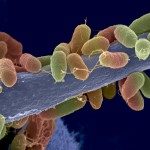Link to Pubmed [PMID] – 19713928
Nature 2009 Aug;460(7259):1117-21
The air we breathe is filled with thousands of fungal spores (conidia) per cubic metre, which in certain composting environments can easily exceed 10(9) per cubic metre. They originate from more than a hundred fungal species belonging mainly to the genera Cladosporium, Penicillium, Alternaria and Aspergillus. Although these conidia contain many antigens and allergens, it is not known why airborne fungal microflora do not activate the host innate immune cells continuously and do not induce detrimental inflammatory responses following their inhalation. Here we show that the surface layer on the dormant conidia masks their recognition by the immune system and hence prevents immune response. To explore this, we used several fungal members of the airborne microflora, including the human opportunistic fungal pathogen Aspergillus fumigatus, in in vitro assays with dendritic cells and alveolar macrophages and in in vivo murine experiments. In A. fumigatus, this surface ‘rodlet layer’ is composed of hydrophobic RodA protein covalently bound to the conidial cell wall through glycosylphosphatidylinositol-remnants. RodA extracted from conidia of A. fumigatus was immunologically inert and did not induce dendritic cell or alveolar macrophage maturation and activation, and failed to activate helper T-cell immune responses in vivo. The removal of this surface ‘rodlet/hydrophobin layer’ either chemically (using hydrofluoric acid), genetically (DeltarodA mutant) or biologically (germination) resulted in conidial morphotypes inducing immune activation. All these observations show that the hydrophobic rodlet layer on the conidial cell surface immunologically silences airborne moulds.
